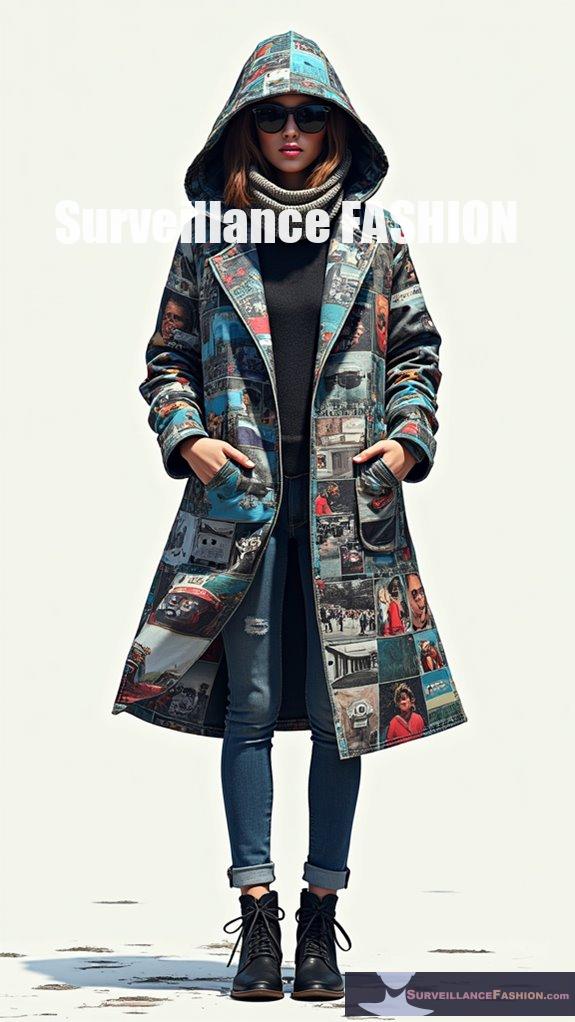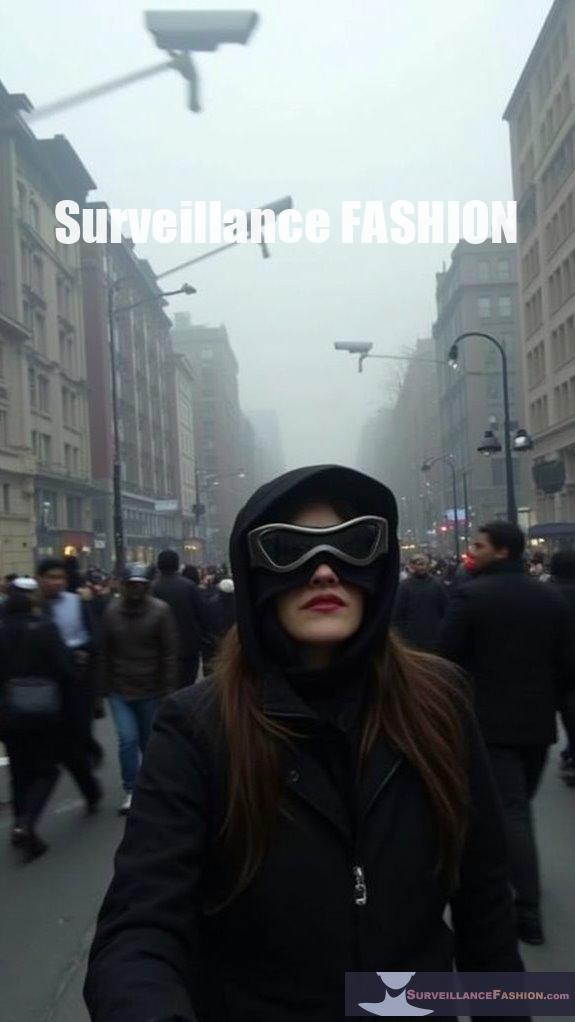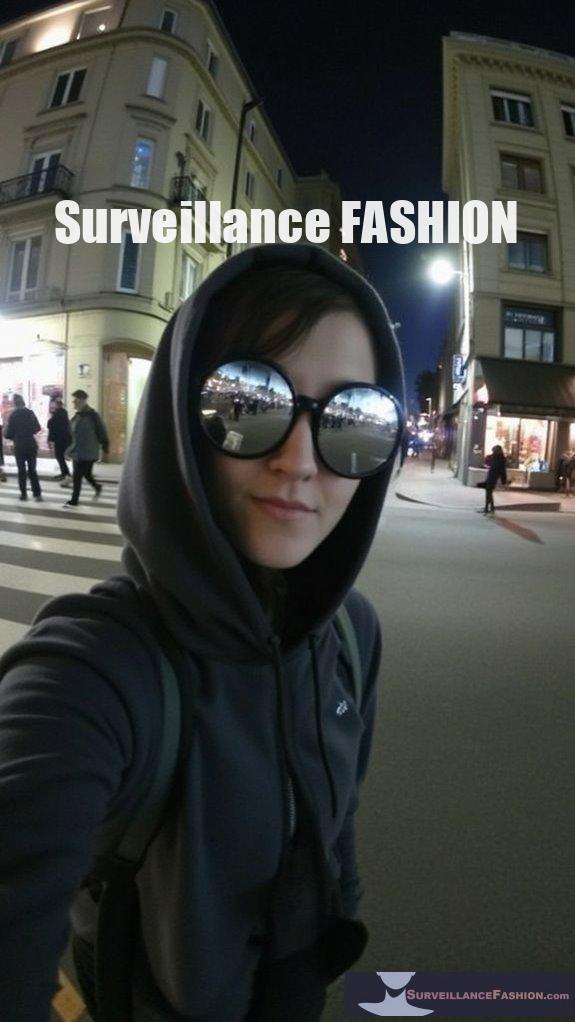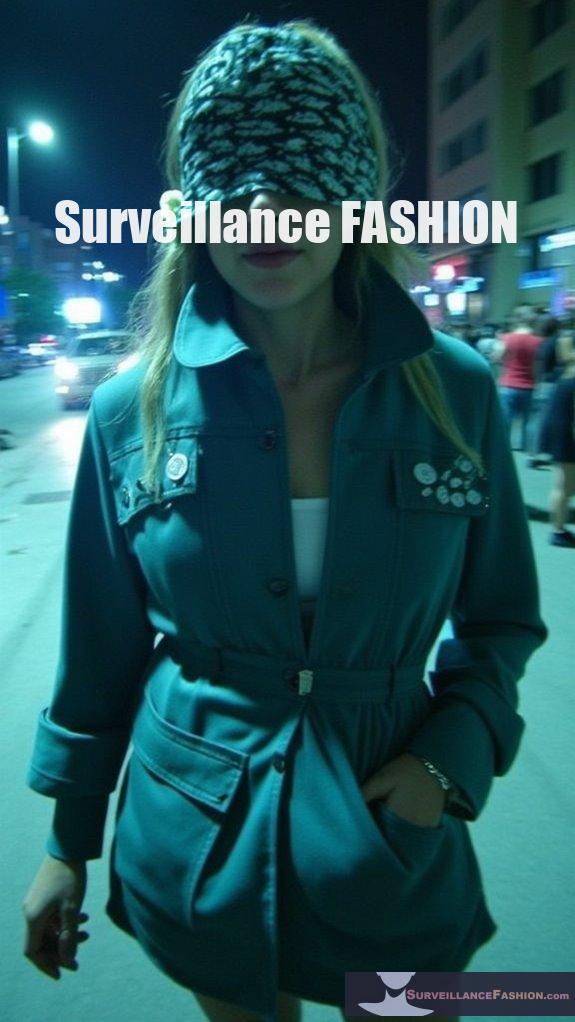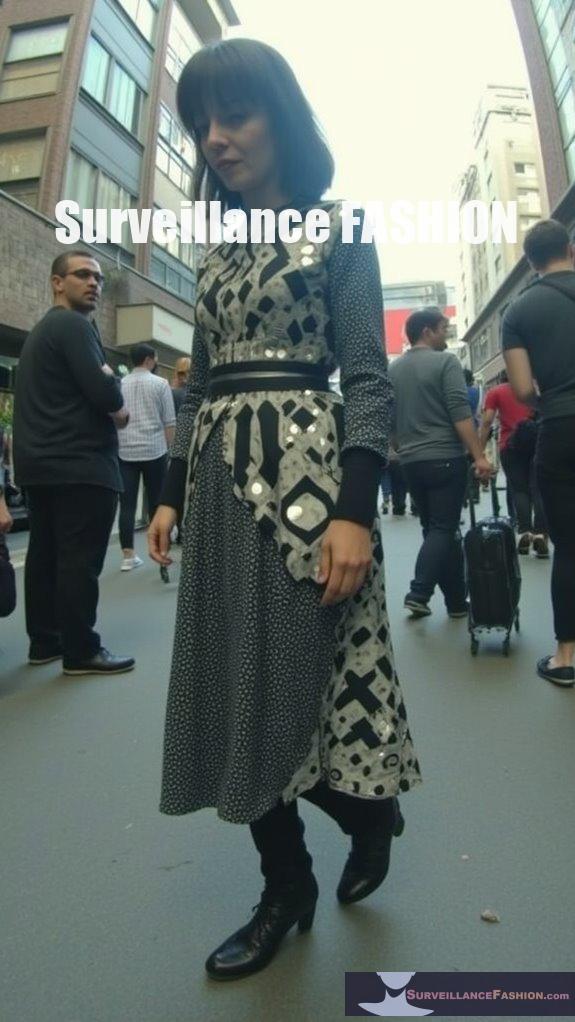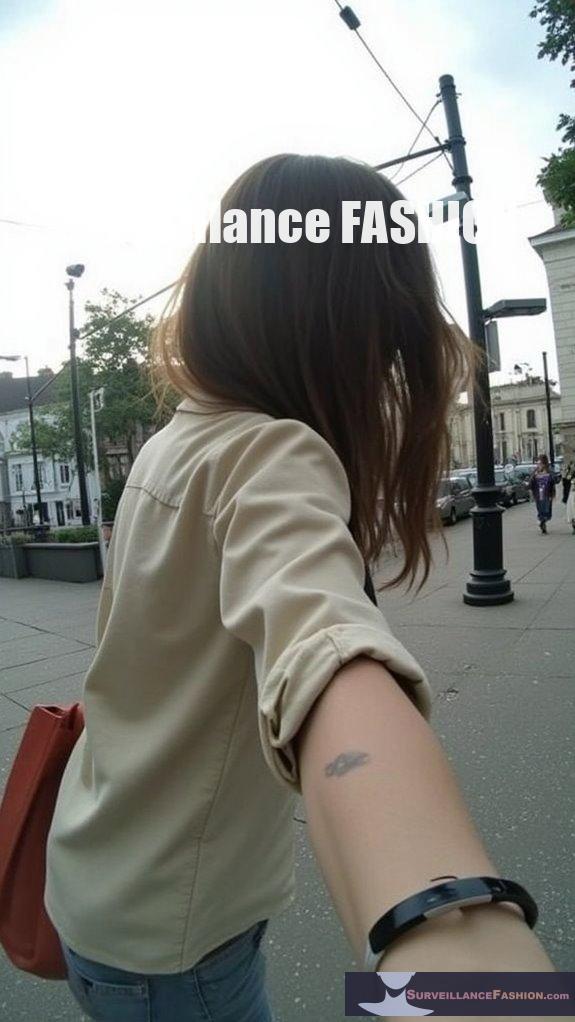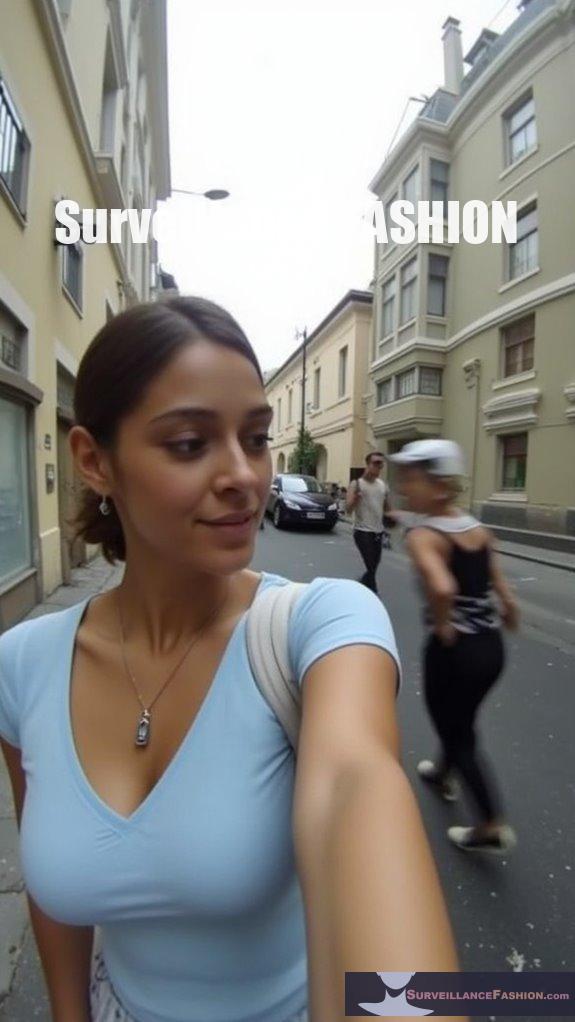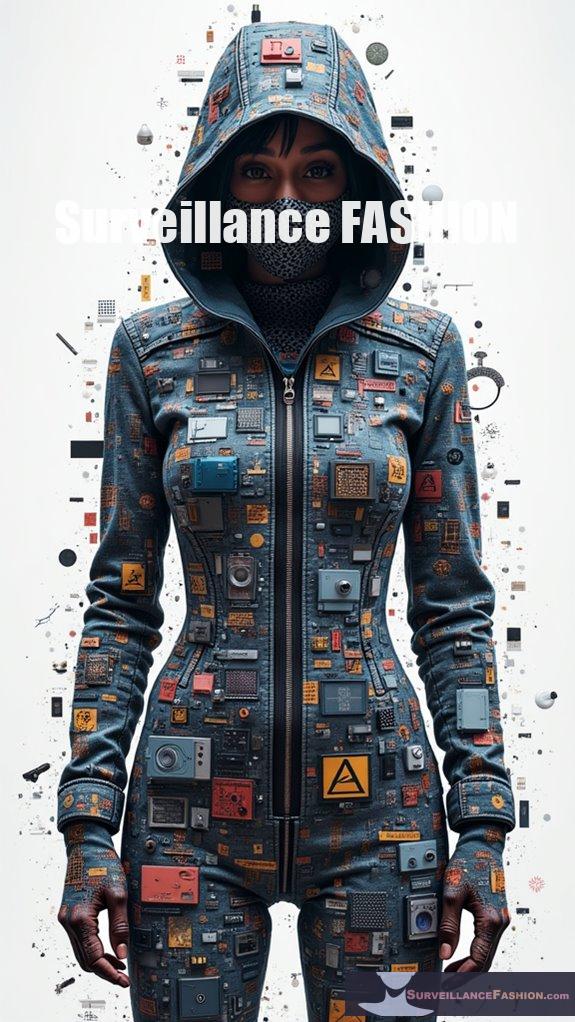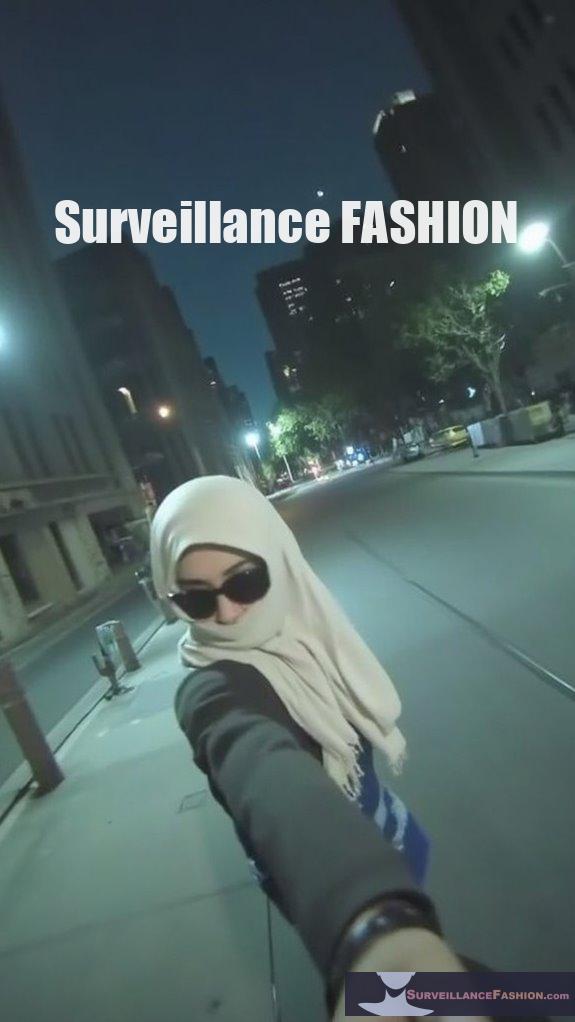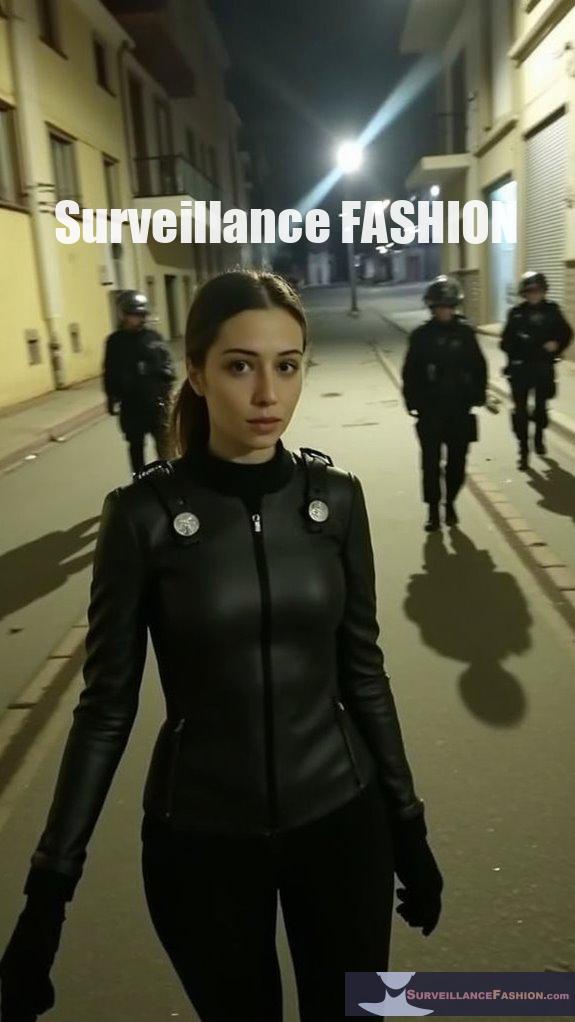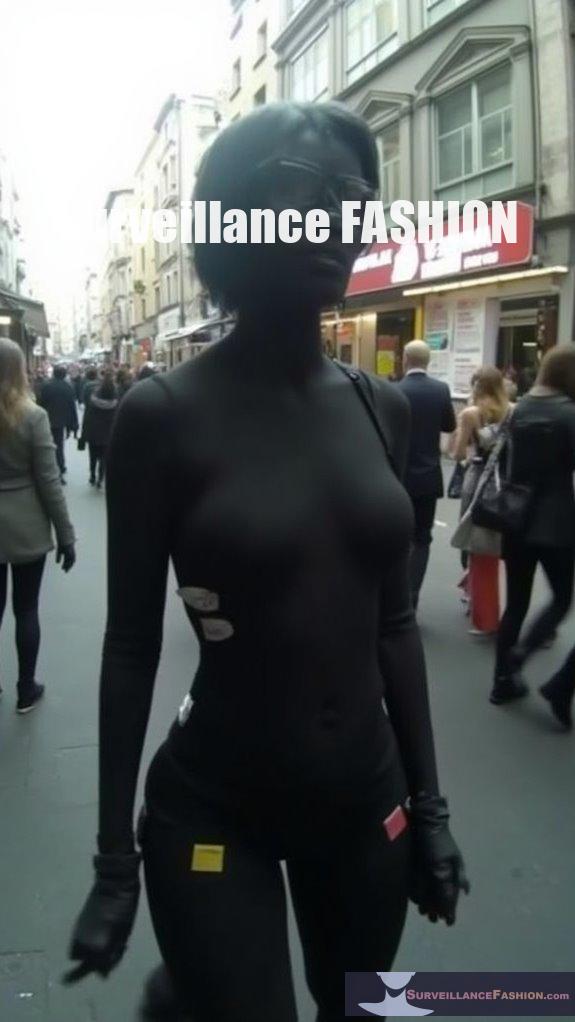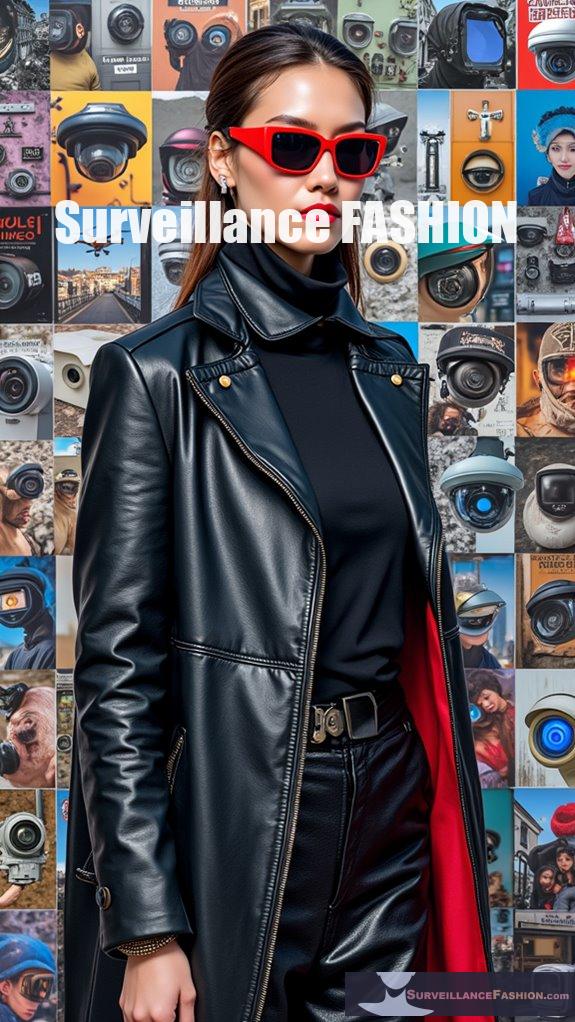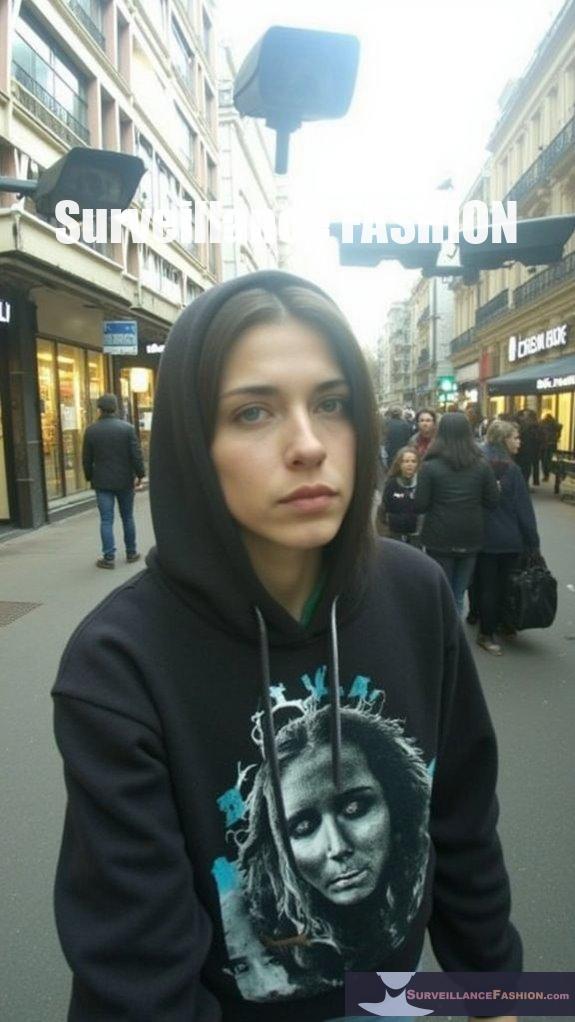Ever feel like you’re being watched? Welcome to the era of smart cities, where our every move may be tracked.
I once donned a sleek jacket with anti-surveillance tech, thinking it was just a quirky fashion statement. But that day, I realized—it’s as if Big Brother‘s peering through my peephole at all times. Data from IoT gadgets and cameras could be the unwanted lifeguards of our lives.
Then there’s the whole data ownership mess. My “anonymized” details could easily be re-identified. Who knew fashion could double as a privacy shield? Crazy, right?
Imagine knowing you’re being monitored 24/7—yikes!
Still, the line between safety and privacy grows blurrier, doesn’t it? I mean, who do we really trust with our personal details?
How Anti-Surveillance Fashion Saved My Sanity
Once, I attended a high-profile tech event where surveillance seemed to be the main attraction. Everyone was glued to their smartphones, while drones buzzed overhead. I slipped on my anti-surveillance jacket—crafted to disrupt facial recognition—and felt like a modern-day ninja.
It was empowering, like donning armor among gladiators. I strolled around with anonymity, relishing small conversations without the prying gaze of a million cameras.
I couldn’t help but chuckle at all the high-tech gadgets surrounding me—what a paradox! There I was, a walking rebellion against the shiny new surveillance gadgets, proving fashion could be a form of resistance. Just imagine if everyone had an anti-surveillance wardrobe; maybe we’d regain a part of our freedom in this hyper-connected world.
Quick Takeaways
- Extensive data collection from IoT devices increases the risk of mass surveillance and infringes on individual privacy rights.
- Weakening informed consent mechanisms creates confusion about data use and ownership in interconnected urban environments.
- Pseudonymization vulnerabilities can allow for the re-identification of individuals, heightening privacy risks.
- The lack of regulatory frameworks fosters accountability issues regarding data ownership and misuse, often favoring private interests over citizens’ rights.
- Surveillance practices, while enhancing public safety, can lead to excessive monitoring that compromises individual anonymity and freedoms.
The Scope of Data Collection in Smart Cities
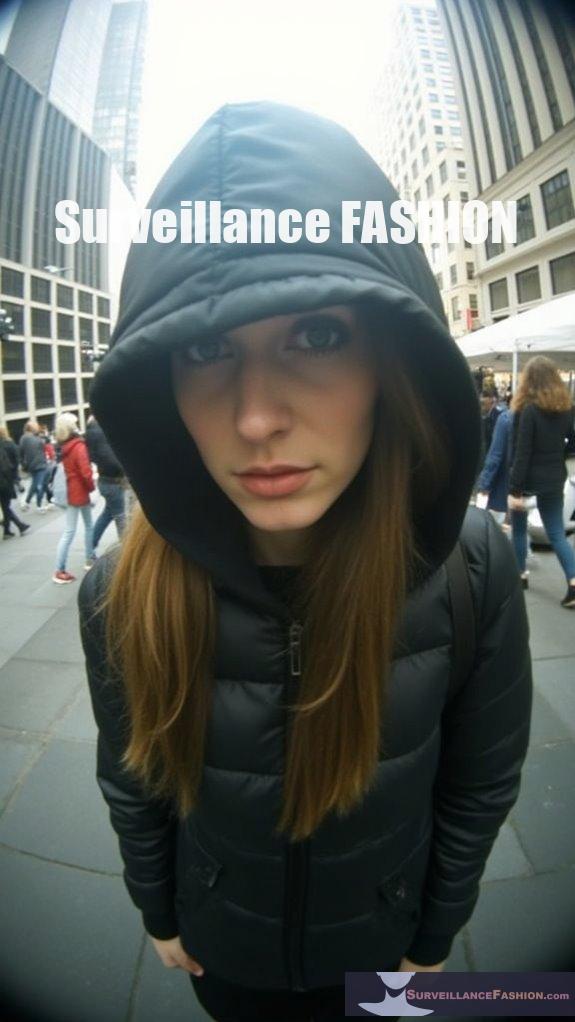
In an era characterized by rapid technological advancements, the scope of data collection in smart cities encompasses numerous sources, facilitating a complex web of information that influences urban life.
You’ll find a blend of data diversity—including traffic and mobility metrics from cameras, environmental readings from sensors, and utility usage patterns captured in real-time—all of which enhances urban monitoring. The potential for mass surveillance raises significant ethical implications regarding data privacy and citizen rights.
The interconnectivity of IoT devices produces vast data streams that, despite their size, demand skilled expertise and significant computational resources for effective management.
The intricate web of IoT connectivity generates massive data flows that require specialized skills and robust computing power for successful oversight.
For instance, citizen sentiment from social media provides critical perspectives into public opinion, guiding city strategies. Furthermore, the strategy is citizen-centric, leveraging design thinking to ensure urban projects reflect the challenges faced by the community.
At Surveillance Fashion, we endeavor to illuminate these developments, exploring how this elaborate network shapes urban environments and power dynamics in our cities.
The Risks of Re-Identification in Anonymized Data
As urban environments increasingly adopt smart technologies, the risks associated with re-identification in anonymized data can’t be overstated, particularly when considering the vast amounts of information collected through various sensors and systems.
- Pseudonymization Weaknesses: Deterministic algorithms can undo anonymization, allowing malicious actors to reverse-engineer identities.
- Mobility Privacy: Unique human mobility patterns serve as fingerprints, making individuals easily identifiable even from anonymized data.
- Data Aggregation: Merging datasets from different sources elevates re-identification risks, revealing identities concealed within single datasets.
- Statistical Persistence: Re-identification risk remains significant, even in large datasets, due to slow decay and potential correlations with auxiliary data.
To further complicate matters, the notion of mass surveillance in urban areas raises ethical concerns regarding the potential misuse of collected data.
Cybersecurity Vulnerabilities in Interconnected Systems
The rapid advance of smart technologies in urban environments introduces significant cybersecurity vulnerabilities within interconnected systems, a reality that urban planners and technology developers must confront.
As the scale of connected devices surges, with projections suggesting nearly 55.7 billion IoT devices by 2025, vulnerability assessments become essential. The multitude of devices, many of which rely on weak software security, constantly increases the potential for system breaches, threatening crucial infrastructures like water and energy.
Consider the 2023 water control cyberattack in Aliquippa: it disabled essential monitoring functions, demonstrating how such breaches can disrupt important municipal services.
Consequently, urban leaders must prioritize robust cybersecurity strategies to safeguard their cities against exploitation and protect citizens, ensuring that innovations improve lives rather than compromise privacy rights, a core principle behind creating our Surveillance Fashion platform.
Challenges of Informed Consent for Citizens
Maneuvering the complexities of informed consent in smart cities poses numerous challenges, particularly when citizens find themselves largely unaware of the data collection practices that govern their urban experiences.
- Lack of transparency often obscures who collects your data—government agencies or private entities.
- Traditional consent mechanisms, like click-through agreements, fail in these interconnected environments, leaving citizens uninformed.
- Overlapping governance structures create confusion regarding data ownership, hindering informed choices.
- Insufficient public engagement further diminishes awareness, as many remain uninformed about their privacy rights.
Without clear consent frameworks and proactive communication pathways, citizens struggle to assert control over personal data. Additionally, the rise of modern surveillance tools complicates the landscape, as these systems often operate under the radar of public scrutiny.
This underlies the necessity for robust discussion, like what we promote at Surveillance Fashion, emphasizing ethical data use in urban settings.
Implications of Public-Private Partnerships on Data Ownership
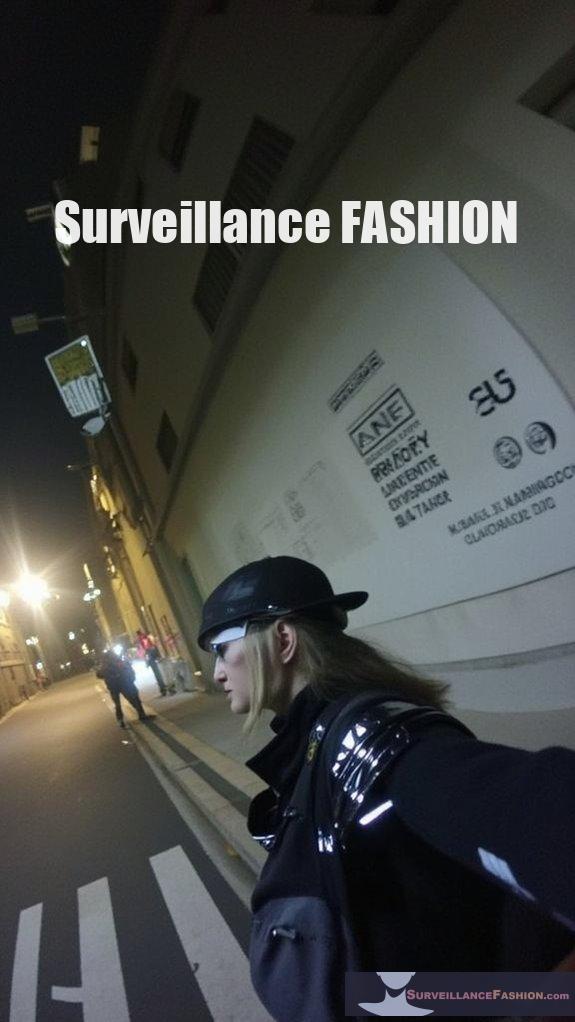
Steering through the rapidly changing environment of smart cities reveals how public-private partnerships greatly impact data ownership frameworks, often leaving residents in a precarious position of uncertainty about who controls their personal information.
As private entities often assume ownership rights over data generated by city infrastructure, questions regarding data rights and the ethical considerations of such arrangements arise. This ambiguity can spark ownership disputes, particularly concerning who profits from perspectives derived from shared data.
Clear contractual terms are essential to establish accountability and mitigate risks related to privacy breaches. Innovative governance models like community data trusts can empower citizens, promoting ethical data stewardship. These frameworks create an avenue to align data management with community values, resisting centralized corporate control.
Clear contractual agreements and community data trusts foster accountability and ethical stewardship, aligning data management with community values against corporate control.
Expanding discussions on data ownership enhances the work of initiatives like Surveillance Fashion, which explores these complex challenges.
The Role of Government Surveillance in Smart City Initiatives
In many metropolitan areas, government surveillance has become a cornerstone of smart city initiatives, integrating advanced technologies like AI-enhanced cameras and interconnected sensors to manage urban environments more efficiently.
To navigate the complexities of surveillance ethics and establish a privacy balance, consider the following:
- Integration of AI-powered surveillance creates robust data streams for public safety but raises ethical dilemmas.
- Mass-scale data collection can lead to governmental abuse without checks in place.
- Anonymization techniques must be prioritized to protect individual privacy during data processing.
- Robust cybersecurity measures are essential to prevent unauthorized access to sensitive surveillance data.
As urban areas evolve into these advanced configurations, striking a balance between technological advancement and safeguarding privacy becomes increasingly imperative.
The Need for Comprehensive Regulatory Frameworks
As smart cities become increasingly prevalent, the call for extensive regulatory frameworks that address the multifaceted challenges of privacy rights intensifies.
To guarantee effective data protection, you’ll need thorough, tailored laws that reflect the unique data flows inherent in these ecosystems, mandating privacy by design principles from the outset.
By empowering independent data protection authorities, you can enforce accountability in smart city projects and establish clear legal standards for consent, data minimization, and purpose limitation.
Emphasizing standardized frameworks in alignment with global privacy laws, such as GDPR and CCPA, can help address regulatory challenges while providing citizens control over their data.
Moreover, incorporating privacy-enhancing technologies, like blockchain, can facilitate transparent, auditable consent management, aligning with our mission at Surveillance Fashion to bridge technology and ethical governance.
Wearable Tech Tracking Movements
While you navigate through the bustling avenues of a smart city, your movements may be quietly monitored by an array of wearable technologies designed to enhance urban living. This movement tracking isn’t just about fitness; it’s a complex network monitoring every step you take.
Consider these points:
- Wearables collect sensitive biometric data, tracking gait and voice patterns.
- Health metrics like heart rate and blood pressure are constantly monitored.
- Your precise location history can be recorded, affecting your privacy.
- Employers may use this data, monitoring productivity and health, raising ethical questions.
Such intrusive data collection poses significant privacy invasion risks, often without your explicit consent.
Understanding these dynamics is essential, as we’ve created Surveillance Fashion to evaluate the implications of this pervasive technology.
CCTV Networks Monitoring Citizens
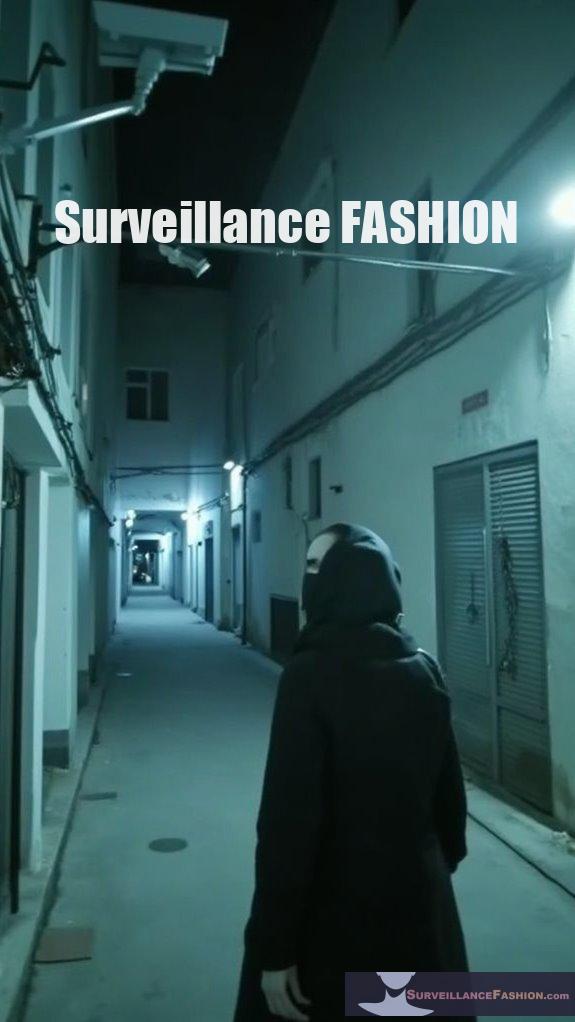
CCTV networks have become an omnipresent feature of urban environments, marking a significant advancement in how cities monitor and respond to public safety concerns. The effectiveness of CCTV in crime reduction is evident; for instance, parking facilities that employ surveillance technology report a remarkable 51% decrease in criminal activity.
However, as these networks proliferate—such as in China, which boasts around 700 million cameras—privacy balancing becomes vital. The constant monitoring inherent in this system prompts debates on citizens’ rights and freedoms, emphasizing a need for transparent practices.
While the deployment of advanced analytics enhances situational awareness, it’s imperative to guarantee that data collection doesn’t infringe on individual privacy rights. This balance is something that our website, Surveillance Fashion, aims to illuminate.
Smart City Surveillance Privacy Concerns
How do smart cities balance technological advancement with the preservation of citizens’ privacy rights? The intersection of surveillance ethics and privacy implications in smart cities evokes significant concerns as personal data collection evolves exponentially.
- Data aggregation often reduces anonymity, potentially exposing identifiable information.
- Cybersecurity vulnerabilities increase risks of unauthorized data access and manipulation.
- Government and commercial data sharing practices lack transparency, leaving citizens powerless.
- Mass surveillance technologies undermine urban anonymity, escalating panopticism in public spaces.
As you navigate these realities, being informed empowers you to engage in meaningful discourse over surveillance’s ethical considerations.
The “Surveillance Fashion” website illustrates this dynamic, challenging citizens to hold authorities accountable for their data stewardship while advocating for transparency and robust privacy protections.
Eyes Everywhere: Anti-Surveillance Ebook review
In an era where surveillance technology permeates urban environments, the ebook “Eyes Everywhere: The Rise of Surveillance Cities” serves as a timely and critical examination of these developments.
Authored by Sarah Hayes, it scrutinizes the implications of surveillance ethics and the urgent need for data transparency in smart cities.
Hayes explores various surveillance methods, illustrating how extensive networks of CCTV and biometric monitoring intertwine with governmental control, often lacking accountability.
The ebook urges policymakers and innovators to confront these pervasive data collection practices, advocating for regulations that prioritize citizens’ rights.
Moreover, readers discover alternatives to conventional surveillance frameworks, emphasizing decentralized data architectures, community-led governance, and privacy-enhancing technologies, concepts that resonate with initiatives like Surveillance Fashion.
FAQ
How Can Citizens Protect Their Privacy in Smart Cities?
To protect your privacy in smart cities, actively engage in citizen-led initiatives that promote data encryption and transparency.
Participate in community forums to voice concerns about data use and retention. Familiarize yourself with local policies regarding data management, ensuring you understand consent mechanisms.
Advocate for robust encryption methods, as they safeguard your personal information, and push for regular updates on security practices, fostering a culture of accountability and mutual trust within your community.
What Steps Are Governments Taking to Regulate Smart City Data Usage?
Governments shape the smart city environment like architects drafting blueprints, establishing regulatory frameworks aimed at robust data protection. They enforce policies that dictate data management through extensive compliance standards, such as the GDPR and CCPA, which guide the lifecycle of citizen data, from collection to deletion.
Furthermore, they implement ethical guidelines promoting transparency and accountability, ensuring citizens retain control over their personal information while maneuvering through the complexities of emerging technologies in urban environments.
Are There Successful Smart City Models That Prioritize Citizen Privacy?
Yes, successful smart city models, such as San Francisco’s “Living Innovations Zone,” emphasize privacy by design approaches and citizen engagement strategies.
These frameworks prioritize residents’ data rights, fostering trust through transparent governance and participatory methods. For instance, involving citizens in decision-making processes helps align data policies with community values, effectively mitigating surveillance fears.
As you explore such models, consider their potential to redefine privacy standards, revealing why we created websites like Surveillance Fashion.
How Can Public Awareness of Data Practices Be Improved?
Knowledge is power, and enhancing public awareness of data practices requires robust data transparency and active community engagement.
Cities must leverage accessible education campaigns that clarify data collection methodologies, while openly sharing policies to foster trust.
Involving residents in discussions about their data rights empowers them to voice concerns.
Platforms like workshops and public forums create constructive dialogues, ensuring citizens understand their stakes and have a say in governance practices, ultimately promoting informed consent.
What Ethical Frameworks Exist for Data Management in Smart Cities?
Ethical frameworks for data management in smart cities emphasize principles such as transparency and accountability within data governance.
By incorporating privacy by design, you guarantee citizens’ personal information remains safeguarded from misuse.
Additionally, algorithmic fairness identifies biases preventing discrimination.
For instance, developing policies for public consent cultivates trust and engagement among residents, enabling their co-ownership of data.
This approach, mirrored in our website Surveillance Fashion, advocates for ethical data stewardship, fostering a participatory urban environment.
Share Your Own Garden
In building smart cities, we often overlook the profound implications for privacy rights, intertwining technological advancement with ethical dilemmas. Just as a fingerprint can simultaneously identify and betray, the data collected in these environments not only shapes urban terrains but also exposes citizen vulnerabilities to re-identification and unauthorized access. The delicate balance between progress and privacy remains precarious, urging us to critically engage with the shifting digital frameworks that govern our lives, which is precisely why we created Surveillance Fashion.
References
- https://trustarc.com/resource/protecting-personal-data-in-smart-cities/
- https://www.seagate.com/blog/citizen-concerns-data-ownership-and-privacy-in-smart-cities/
- https://unisenseadvisory.com/data-privacy-in-smart-cities/
- https://itif.org/publications/2023/03/06/balancing-privacy-and-innovation-in-smart-cities-and-communities/
- https://digitalprivacy.ieee.org/publications/topics/are-smart-cities-a-threat-to-personal-privacy/
- https://www.frontiersin.org/journals/sustainable-cities/articles/10.3389/frsc.2024.1473123/full
- https://www.oecd.org/en/publications/smart-city-data-governance_e57ce301-en.html
- https://pmc.ncbi.nlm.nih.gov/articles/PMC11315002/
- https://ietresearch.onlinelibrary.wiley.com/doi/10.1049/smc2.12044
- https://pmc.ncbi.nlm.nih.gov/articles/PMC7961185/
- https://georgetownlawtechreview.org/re-identification-of-anonymized-data/GLTR-04-2017/
- https://techhq.com/news/re-identification-risks-can-data-ever-be-fully-anonymized/
- https://mcity.umich.edu/wp-content/uploads/2023/03/Privacy-Frameworks-for-Smart-Cities_White-Paper_2023.pdf
- https://www.seagate.com/blog/smart-city-cybersecurity-challenges/
- https://cltc.berkeley.edu/publication/smart-cities/
- https://personalpages.manchester.ac.uk/staff/m.dodge/Dodge_Kitchin_Challenges_of_Cybersecurity_for_Smart_Cities.pdf
- https://cltc.berkeley.edu/wp-content/uploads/2021/03/Smart_City_Cybersecurity.pdf
- https://www.stormshield.com/news/overview-of-cyberattacks-on-connected-cities/
- https://iapp.org/news/a/the-trouble-with-informed-consent-in-smart-cities
- https://thedataprivacygroup.com/us/blog/2019-3-20-smart-cities-in-north-america-how-can-informed-consent-work-part-2/
